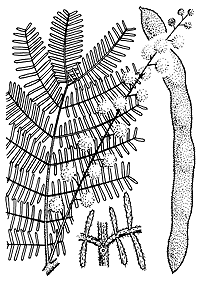Common name: hairy silver wattle, velvet Acacia, hoary silver wattle
Acacia mollifolia Maiden & Blakely APNI* Synonyms: Racosperma mollifolium (Maiden & Blakely) Pedley APNI*
Acacia decurrens var. lanigera Maiden APNI*

Description: Spreading or erect shrub to small tree 1.5–6 m high; bark smooth to finely fissured, grey to black or dark brown; branchlets ± terete with low ridges, pale rusty to silvery grey-velvety.
Leaves silvery grey, with petiole 0.2–0.7 cm long, densely hairy, 1 gland at base of or near lowest pair of pinnae; rachis 1–4.5 (rarely to 6.5) cm long, densely hairy, jugary glands present (hairy and often obscured by rachis hairs), interjugary glands absent; pinnae 4–10 pairs, 0.8–4 cm long; pinnules 7–27 pairs, narrowly oblong to linear, 2.5–7.5 mm long, 0.5–0.8 mm wide, covered with long fine silvery hairs.
Inflorescences in axillary racemes or terminal panicles; peduncles 2–7 mm long, hairy; heads globose, 20–40-flowered, 3–6 mm diam., bright yellow.
Pods straight to slightly curved, ± flat, usually ± submoniliform or barely constricted between seeds, 3–12 cm long, 4–7 mm wide, leathery, densely silvery grey- to rusty-hairy; seeds longitudinal; funicle expanded towards seed.
Flowering: recorded February–May, July-August, November.
Distribution and occurrence: chiefly west from the Peak Hill, Bathurst and Boorowa area to Rankins Springs. Grows in dry sclerophyll forest to open woodland, generally on sandstone, often on ridges.
NSW subdivisions: CT, CWS, SWP
May be confused with Acacia leucoclada subsp. argentifolia which has more pairs of pinnae and interjugary glands; their distributions are also widely separated. The name is derived from the Latin 'mollis' (soft, pliant) and 'folium' (a leaf), referring the plants softly hairy leaves.
Text by P.G. Kodela (last edited February 2009)
Taxon concept: P.G. Kodela & G.J. Harden, Flora of NSW Vol. 2 (2002)
APNI* Provides a link to the Australian Plant Name Index (hosted by the Australian National Botanic Gardens) for comprehensive bibliographic data
***The AVH map option provides a detailed interactive Australia wide distribution map drawn from collections held by all major Australian herbaria participating in the Australian Virtual Herbarium project.
|


